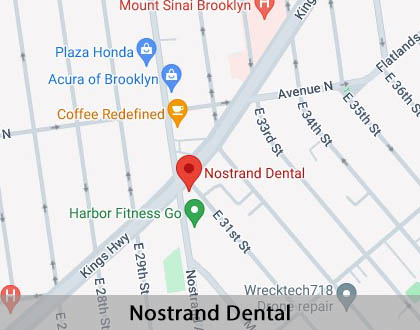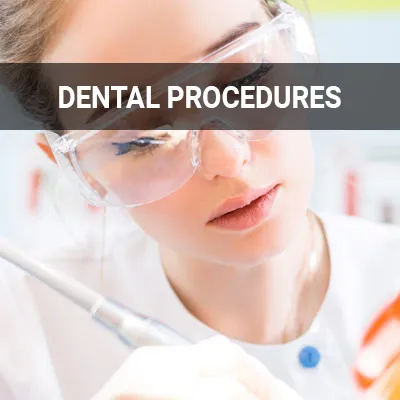Root Scaling and Planing Brooklyn, NY
Patients with gum disease can benefit from root scaling and planing. This treatment is a key part of restoring healthy gums and teeth. Root scaling and planing treatments can combat the harmful effects of gum disease and keep your mouth healthy.
Root scaling and root planing treatments are available at Nostrand Dental in Brooklyn and the surrounding area. Our team can help improve your oral health. Call us at (718) 513-9685 to learn more about our services or schedule an appointment.
An Overview of Root Scaling and Planing
Root scaling is a periodontal treatment that deep cleans the gums. This treatment is more extensive than the routine cleaning during a regular dental check-up. We will remove all plaque, bacterial toxins, and tartar deposits from the teeth and root surfaces during the procedure. A dental scaler or ultrasonic instrument can also assist in clearing the bacterial buildup.
For even deeper cleaning, patients can also have a root planing treatment. During root planing, we will clean under the gum line to remove plaque and tartar. The root surface of the gums is smoothed and treated to keep gum disease from progressing. These non-surgical procedures aim to remove bacteria from the gum and root with patients with deep periodontal pockets.
” These non-surgical procedures aim to remove bacteria from the gum and root with patients with deep periodontal pockets.”
When To Receive Root Scaling and Planing
We recommend root scaling and root planing to combat chronic periodontal disease, also known as gum disease. Patients with receding gums can also benefit from this treatment. During a routine dental examination, we will assess the patient's gum line and periodontal pockets. Deep pockets may indicate signs of periodontal disease and necessitate root scaling or planing.
Without root scaling or root planing treatment, people with periodontal disease can suffer additional oral and overall health problems. Eventually, the bacteria from diseased gums can lead to receding gums, tooth loss, bone loss, or loose teeth. Root scaling and planing can help repair some of the damage and prevent further gum damage. Additional treatments may be necessary in cases where the periodontal pockets have become deeper.
“Without root scaling or root planing treatment, people with periodontal disease can suffer additional oral and overall health problems.”
A Breakdown of the Procedure
Depending on the severity of the situation, root scaling and planing treatments may be broken up into multiple appointments. These procedures are done on an outpatient basis. Patients may or may not need a local anesthetic to numb the treatment site. We may focus on certain parts of the mouth during each appointment instead of treating the entire area in one visit.
Root scaling occurs before root planing. We will scrape plaque deposits from the teeth and in the large pockets between the gums during root scaling. During root planing, we will go deeper into the gum line to remove bacteria and plaque. We will smooth out the roots deep within the gum line, clearing off tartar build-up and bacteria. At the end of the procedure, the gums and mouth are flushed with water to remove any remaining loose residue or bacteria.
“Depending on the severity of the situation, root scaling and planing treatments may be broken up into multiple appointments.”
Check out what others are saying about our dental services on Yelp: Root Scaling and Planing in Brooklyn, NY
Benefits and Drawbacks of Root Scaling and Planing
Root scaling and planing remove hidden pockets of infection below the gumline. This procedure also deep cleans to eliminate plaque and tartar. Most patients respond well to root scaling and planing. This procedure can treat even stubborn cases of gum disease. It may also prevent future dental concerns like decay or abscess.
However, like any dental procedure, root scaling and planing carry some risk. Occasionally, patients may experience oral bleeding or irritation. Patients may also have an allergic reaction to the materials or medications used during treatment. Rest assured that serious side effects are rare. Our dental team takes every precaution for our patient's safety.
Sometimes, a single root scaling and planing procedure may not resolve the underlying problem. Patients may need further treatments, including oral medication. Patients with chronic gum disease may also need repeated procedures. Our dental team can explain what to do if gum disease persists after root scaling and planing.
“Most patients respond well to root scaling and planing.”
Questions Answered on This Page
Q. What are root scaling and root planing?
Q. When are root scaling and root planing necessary?
Q. What happens during a typical root scaling and root planing procedure?
Q. What aftercare should occur after treatment?
Q. What are the benefits and drawbacks of root scaling?
People Also Ask
Q. Am I at high risk for developing oral cancer?
Q. What is the difference between endodontists and dentists?
Q. What are some common signs of receding gums?
Treatment Aftercare
Gum sensitivity is normal during the first few days after this deep cleaning treatment. The gums may be tender, swollen, and even bleed. We recommend that patients gently brush their teeth and use wax-coated floss. They should also periodically rinse their mouth with warm salt water or an oral rinse to prevent infection.
A follow-up appointment is necessary so that we can check for gum improvement. If the gums are firm and pink again and the pockets are smaller, patients may not need further treatment. People can then schedule regular dental check-ups to maintain gum and oral health.
“If the gums are firm and pink again and the pockets are smaller, patients may not need further treatment.”
Frequently Asked Questions
Q. Is root scaling and planing painful?
A. Dental providers use numbing medication to prevent patients from feeling discomfort during treatment. Afterward, patients may experience sore or tender gums. However, these side effects usually disappear within a few days.
Q. How long will it take for my gums to recover?
A. Most patients make a full recovery within 1-2 weeks. Keep in mind that some patients may need frequent scaling and planing. Annual or biannual procedures can prevent gum disease from returning. Our team can determine whether you need ongoing treatment.
Q. How long does the procedure last?
A. Root scaling and planing usually take 1-2 hours. The dental provider may perform the treatment in one visit, or they may split the procedure into two stages. Our team can determine the right treatment schedule for you.
Q. What are the risks of root scaling and planing?
A. Most patients are eligible for root scaling and planing procedures. However, this treatment may not be right for patients with bleeding disorders or compromised immune systems. Patients with severe tooth decay or oral infections may benefit from a different treatment. Our team can determine whether you are a candidate for root scaling and planing.
Q. How can I know if I need this procedure?
A. Root scaling and planing can treat an advanced form of gum disease known as periodontitis. Periodontitis symptoms may include:
- Swollen gums
- Red or purplish gums
- Gum bleeding
- Bad breath
- Visible pus along the gumline
Untreated periodontitis can result in tooth loss, receding gums, and widespread infection. Researchers have also found that patients with periodontitis are at a higher risk for heart disease and dementia. Treatment helps patients resolve gum disease and other issues that may occur from gum disease.
Periodontic Terminology
Call Us Today
If you have gum disease, root scaling and planing can help reverse this issue. Our team at Nostrand Dental can help. Call us today at 718-513-9685 to learn more about our services or schedule an appointment.
Helpful Related Links
- American Dental Association (ADA). Glossary of Dental Clinical Terms. 2024
- American Academy of Cosmetic Dentistry® (AACD). Home Page. 2024
- WebMD. WebMD’s Oral Care Guide. 2024
About our business, license, and website security
- Nostrand Dental was established in 1998.
- We accept the following payment methods: Cash, CareCredit, Check, Discover, MasterCard, and Visa
- We serve patients from the following counties: Kings County, New York County, Richmond County, Queens County, and Nassau County
- We serve patients from the following cities: Brooklyn, Manhattan, Queens, Staten Island, and Long Island
- NY (License #46702). View License Information and Specifics
- National Provider Identifier Database (1457434540). View NPI Registry Information
- Norton Safe Web. View Details
- Trend Micro Site Safety Center. View Details
Back to top of Root Scaling and Planing











